Sony CDX-A360 User Manual
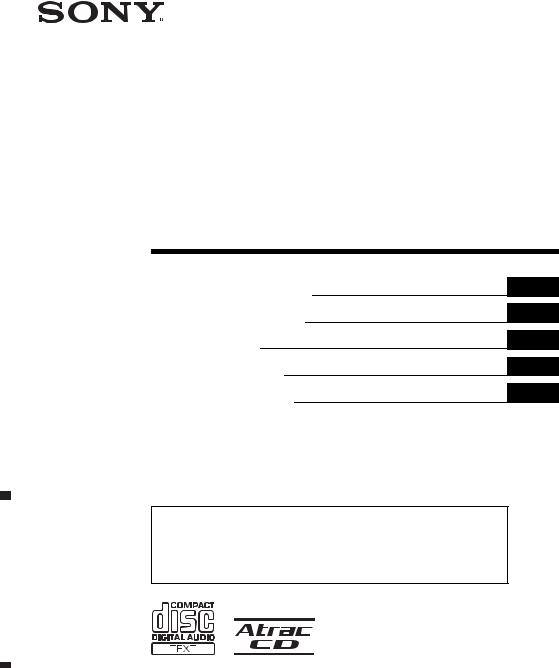
2-650-614-51 (1)
FM/MW/LW
Compact Disc Player
Operating Instructions
Bedienungsanleitung
Mode d’emploi
Istruzioni per l’uso
Gebruiksaanwijzing
GB
DE
FR
IT
NL
To cancel the demonstration (DEMO) display, see page 11.
Zum Deaktivieren der Demo-Anzeige (DEMO) schlagen Sie bitte auf Seite 13 nach. Pour annuler la démonstration (DEMO), reportez-vous à la page 12.
Per annullare la dimostrazione (DEMO), vedere pagina 13. Om de demonstratie (DEMO) te annuleren, zie pagina 12.
CDX-A360
© 2007 Sony Corporation

For installation and connections, see the supplied installation/connections manual.
Warning if your car’s ignition has no ACC position
After turning the ignition off, be sure to press and hold (OFF) on the unit until the display disappears.
Otherwise, the display does not turn off and this causes battery drain.
This label is located on the bottom of the chassis.
Disposal of Old Electrical & Electronic Equipment (Applicable in the European Union and other European countries with separate collection systems)
This symbol on the product or on its packaging indicates that this product shall not be treated as household waste. Instead it shall be handed over to the applicable collection point for the recycling of electrical and electronic equipment. By ensuring this product is disposed of correctly, you will help prevent potential negative consequences for the environment and human health, which could otherwise be caused by inappropriate waste handling of this product. The recycling of materials will help to conserve natural resources. For more detailed information about recycling of this product, please contact your local Civic Office, your household waste disposal service or the shop where you purchased the product.
Applicable accessory: Remote commander
SonicStage and its logo are trademarks of Sony Corporation.
ATRAC, ATRAC3, ATRAC3plus and their logos are trademarks of Sony Corporation.
Microsoft, Windows Media, and the Windows logo are
trademarks or registered trademarks of Microsoft
Corporation in the United States and/or other countries.
2

Table of Contents
Welcome ! . . . . . . . . . . . . . . . . . . . . . . . . . . . . . 4
Getting Started
Resetting the unit. . . . . . . . . . . . . . . . . . . . . . . . 4 Preparing the card remote commander . . . . . . . 4 Setting the clock . . . . . . . . . . . . . . . . . . . . . . . . 5 Detaching the front panel . . . . . . . . . . . . . . . . . 5 Attaching the front panel . . . . . . . . . . . . . . . 5
Location of controls and basic operations
Main unit. . . . . . . . . . . . . . . . . . . . . . . . . . . . 6 Card remote commander RM-X151 . . . . . . . 6
CD
Display items . . . . . . . . . . . . . . . . . . . . . . . . 8 Repeat and shuffle play. . . . . . . . . . . . . . . . . 8
Radio
Storing and receiving stations . . . . . . . . . . . . . . 8 Storing automatically — BTM . . . . . . . . . . . 8 Storing manually. . . . . . . . . . . . . . . . . . . . . . 8 Receiving the stored stations . . . . . . . . . . . . 8 Tuning automatically . . . . . . . . . . . . . . . . . . 8
RDS . . . . . . . . . . . . . . . . . . . . . . . . . . . . . . . . . . 9 Overview. . . . . . . . . . . . . . . . . . . . . . . . . . . . 9 Setting AF and TA . . . . . . . . . . . . . . . . . . . . 9 Selecting PTY . . . . . . . . . . . . . . . . . . . . . . . 10 Setting CT . . . . . . . . . . . . . . . . . . . . . . . . . . 10
Other functions
Changing the sound settings . . . . . . . . . . . . . . 11 Adjusting the sound characteristics
— BAL/FAD/SUB. . . . . . . . . . . . . . . . . . . 11 Customizing the equalizer curve
— EQ3 . . . . . . . . . . . . . . . . . . . . . . . . . . . . 11 Adjusting setup items — SET . . . . . . . . . . . . 11 Using optional equipment. . . . . . . . . . . . . . . . 12 Auxiliary audio equipment. . . . . . . . . . . . . 12
Additional Information
Precautions . . . . . . . . . . . . . . . . . . . . . . . . . . . 13 Notes on discs . . . . . . . . . . . . . . . . . . . . . . 13 About MP3/WMA files . . . . . . . . . . . . . . . 13 About ATRAC CD. . . . . . . . . . . . . . . . . . . 14 Maintenance . . . . . . . . . . . . . . . . . . . . . . . . . . 14 Removing the unit. . . . . . . . . . . . . . . . . . . . . . 15 Specifications . . . . . . . . . . . . . . . . . . . . . . . . . 16 Troubleshooting . . . . . . . . . . . . . . . . . . . . . . . 16 Error displays/Messages. . . . . . . . . . . . . . . 17
3
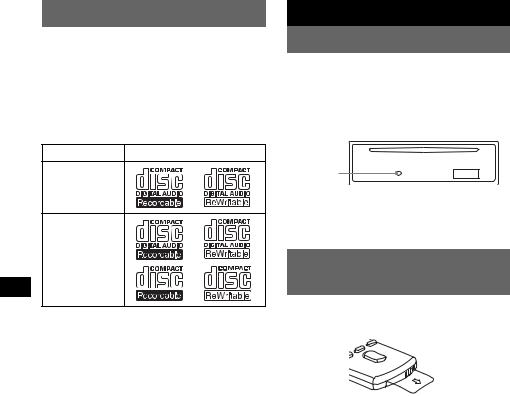
Welcome !
Thank you for purchasing this Sony Compact Disc Player. You can enjoy your drive with the following functions.
•CD playback
You can play CD-DA (also containing CD TEXT*), CD-R/CD-RW (MP3/WMA files also containing Multi Session (page 13)), and ATRAC CD (ATRAC3 and ATRAC3plus format (page 14)).
Type of discs |
Label on the disc |
CD-DA
MP3
WMA
ATRAC CD
•Radio reception
–You can store up to 6 stations per band (FM1, FM2, FM3, MW and LW).
–BTM (Best Tuning Memory): The unit selects strong signal stations and stores them.
•RDS services
–You can use FM station with Radio Data System (RDS).
•Sound adjustment
–EQ3: You can select an equalizer curve for 7 music types.
•Auxiliary equipment connection
–An AUX input jack on the front of the unit allows connection of a portable audio device.
*A CD TEXT disc is a CD-DA that includes information such as disc, artist and track name.
Getting Started
Resetting the unit
Before operating the unit for the first time, or after replacing the car battery or changing the connections, you must reset the unit.
Detach the front panel and press the RESET button with a pointed object, such as a ball-point pen.
RESET button
Note
Pressing the RESET button will erase the clock setting and some stored contents.
Preparing the card remote commander
Before using the card remote commander for the first time, remove the insulation film.
4
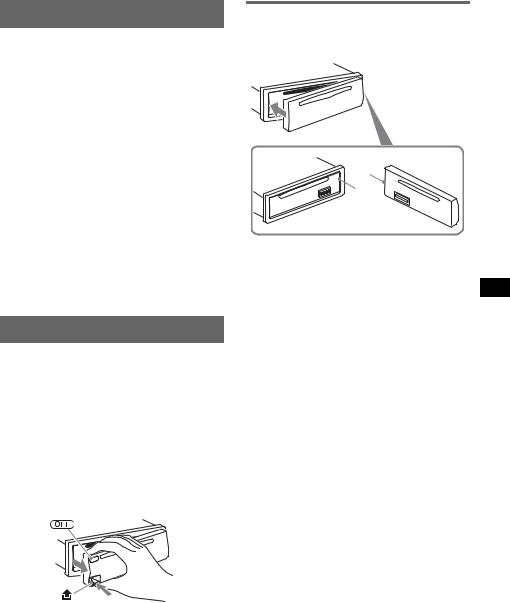
Setting the clock
The clock uses a 24-hour digital indication.
1Press and hold the select button.
The setup display appears.
2Press the select button repeatedly until “CLOCK-ADJ” appears.
3Press (DSPL).
The hour indication flashes.
4Rotate the volume control dial to set the hour and minute.
To move the digital indication, press (DSPL).
5Press the select button.
The setup is complete and the clock starts.
To display the clock, press (DSPL). Press (DSPL) again to return to the previous display.
Tip
You can set the clock automatically with the RDS feature (page 10).
With the card remote commander
In step 4, to set the hour and minute, press M or m.
Detaching the front panel
You can detach the front panel of this unit to prevent theft.
Caution alarm
If you turn the ignition switch to the OFF position without detaching the front panel, the caution alarm will sound for a few seconds. The alarm will only sound if the built-in amplifier is used.
1Press (OFF).
The unit is turned off.
2Press  , then pull it off towards you.
, then pull it off towards you.
Attaching the front panel
Engage part A of the front panel with part B of the unit, as illustrated, and push the left side into position until it clicks.
A
B
Note
Do not put anything on the inner surface of the front panel.
Notes
•Do not drop or put excessive pressure on the front panel and display window.
•Do not subject the front panel to heat/high temperature or moisture. Avoid leaving it in a parked car or on a dashboard/rear tray.
5
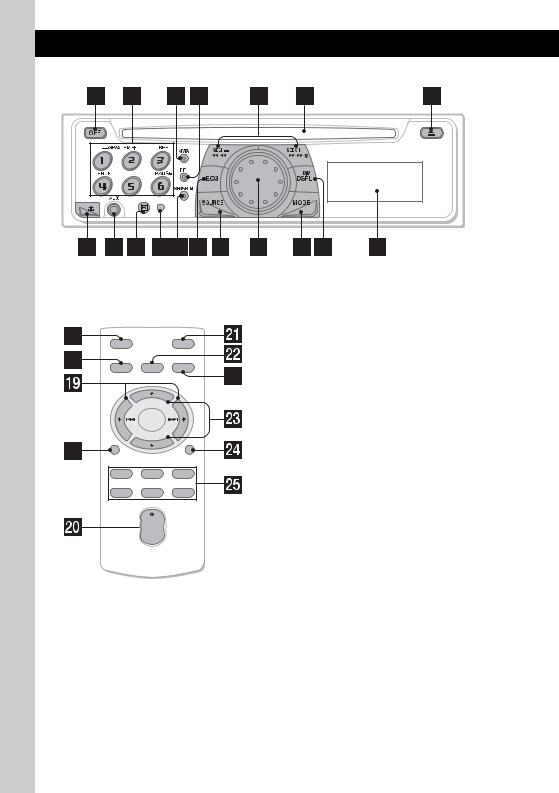
Location of controls and basic operations
Main unit
Card remote commander RM-X151
OFF |
ATT |
SOURCE SEL MODE
+
–
DSPL |
|
SCRL |
1 |
2 |
3 |
4 |
5 |
6 |
+
 VOL
VOL
–
CDX-A360
Refer to the pages listed for details. The corresponding buttons on the card remote commander control the same functions as those on the unit.
AOFF button
To power off; stop the source.
B Number buttons
CD:
(1)/(2): GP*1/ALBM*2 –/+
To skip groups/albums (press); skip groups/albums continuously (press and hold).
(3): REP 8
(4): SHUF 8
(6): PAUSE
To pause playback. To cancel, press again.
Radio:
To receive stored stations (press); store stations (press and hold).
CAF (Alternative Frequencies)/TA (Traffic Announcement) button 9
To set AF and TA in RDS.
DPTY (Program Type) button 10
To select PTY in RDS.
6

ESEEK –/+ buttons
CD:
To skip tracks (press); skip tracks continuously (press, then press again within about 1 second and hold); reverse/fastforward a track (press and hold).
Radio:
To tune in stations automatically (press); find a station manually (press and hold).
FDisc slot
To insert the disc (label side up). Playback starts automatically.
GZ (eject) button
To eject the disc.
H  (front panel release) button 5
(front panel release) button 5
IAUX input jack 12
To connect a portable audio device.
JReceptor for the card remote commander
KRESET button (located behind the front panel) 4
LSENS/BTM button
To improve weak reception: LOCAL/MONO (press); start the BTM function (press and hold).
MEQ3 (equalizer) button 11
To select an equalizer type (XPLOD, VOCAL, CLUB, JAZZ, NEW AGE, ROCK, CUSTOM or OFF).
NSOURCE button
To power on; change the source (Radio/CD/ AUX).
OVolume control dial/select button 11
To adjust volume (rotate); select setup items (press and rotate).
PMODE button 8
To select the radio band (FM/MW/LW).
QDSPL (display)/DIM (dimmer) button
5, 8
To change display items (press); change the display brightness (press and hold).
R Display window
The following buttons on the card remote commander have also different buttons/functions from the unit. Remove the insulation film before use (page 4).
ql < (.)/, (>) buttons
To control CD/radio, the same as (SEEK) –/+ on the unit.
w; VOL (volume) +/– button
To adjust volume.
wa ATT (attenuate) button
To attenuate the sound. To cancel, press again.
ws SEL (select) button
To select items.
wd M (+)/m (–) buttons
To control CD, the same as (1)/(2) –/+ on the unit.
wf SCRL (scroll) button 8
To scroll the display item.
wg Number buttons
To receive stored stations (press); store stations (press and hold).
*1 When an ATRAC CD is played.
*2 When an MP3/WMA is played.
Note
If the unit is turned off and the display disappears, it cannot be operated with the card remote commander unless (SOURCE) on the unit is pressed, or a disc is inserted to activate the unit first.
Tip
For details on how to replace the battery, see “Replacing the lithium battery of the card remote commander” on page 14.
7
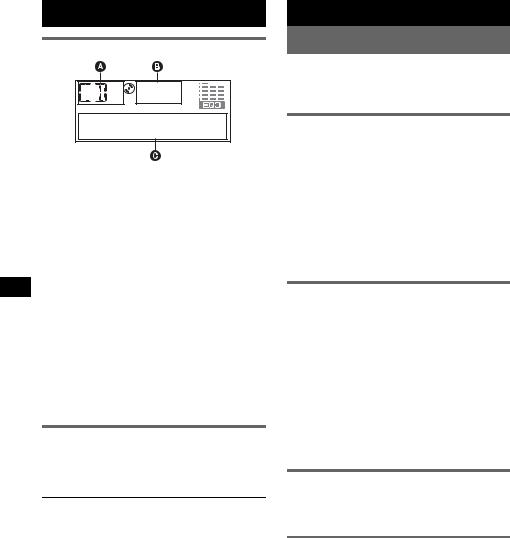
CD
Display items
A Source
B WMA/MP3/ATRAC CD indication
CTrack number/Elapsed playing time, Disc/ artist name, Album/group number*1, Album/ group name, Track name, Text information*2, Clock
*1 Album/group number is displayed only when the album/group is changed.
*2 When playing an MP3, ID3 tag is displayed, when playing ATRAC CD, text information written by SonicStage, etc., is displayed, and when playing WMA, WMA tag is displayed.
To change display items C, press (DSPL); scroll display items C, press (SCRL) on the card remote commander or set “A.SCRL-ON” (page 12).
Tip
Displayed items will differ, depending on the disc type, recorded format and settings. For details on MP3/ WMA, see page 13; ATRAC CD, see page 14.
Repeat and shuffle play
1During playback, press (3) (REP) or
(4) (SHUF) repeatedly until the desired setting appears.
Select |
To play |
|
REP-TRACK |
track repeatedly. |
|
|
|
|
REP-ALBM*1 |
album repeatedly. |
|
REP-GP*2 |
group repeatedly. |
|
SHUF-ALBM*1 |
album in random order. |
|
SHUF-GP*2 |
group in random order. |
|
SHUF-DISC |
disc in random order. |
|
|
|
|
*1 |
When an MP3/WMA is played. |
|
*2 |
When an ATRAC CD is played. |
|
To return to normal play mode, select “REPOFF” or “SHUF-OFF.”
Radio
Storing and receiving stations
Caution
When tuning in stations while driving, use Best Tuning Memory (BTM) to prevent an accident.
Storing automatically — BTM
1Press (SOURCE) repeatedly until
“TUNER” appears.
To change the band, press (MODE) repeatedly. You can select from FM1, FM2, FM3, MW or LW.
2Press and hold (SENS/BTM) until
“BTM” flashes.
The unit stores stations in order of frequency on the number buttons.
A beep sounds when the setting is stored.
Storing manually
1While receiving the station that you want to store, press and hold a number button ((1) to (6)) until
“MEM” appears.
The number button indication appears in the display.
Note
If you try to store another station on the same number button, the previous stored station will be replaced.
Tip
When a RDS station is stored, the AF/TA setting is also stored (page 9).
Receiving the stored stations
1Select the band, then press a number button ((1) to (6)).
Tuning automatically
1Select the band, then press (SEEK) –/+ to search for the station.
Scanning stops when the unit receives a station. Repeat this procedure until the desired station is received.
Tip
If you know the frequency of the station you want to listen to, press and hold (SEEK) –/+ to locate the approximate frequency, then press (SEEK) –/+ repeatedly to fine adjust to the desired frequency (manual tuning).
8

RDS
Overview
FM stations with Radio Data System (RDS) service send inaudible digital information along with the regular radio program signal.
Display items
A Radio band, Function
B TA/TP*1
CFrequency*2 (Program service name), Preset number, Clock, RDS data
*1 “TA” flashes during traffic information. “TP” lights up while such a station is received.
*2 While receiving the RDS station, “ *” is displayed on the left of the frequency indication.
To change display items C, press (DSPL).
RDS services
This unit automatically provides RDS services as follows:
AF (Alternative Frequencies)
Selects and retunes the station with the strongest signal in a network. By using this function, you can continuously listen to the same program during a long-distance drive without having to retune the same station manually.
TA (Traffic Announcement)/TP (Traffic Program)
Provides current traffic information/programs. Any information/program received, will interrupt the currently selected source.
PTY (Program Types)
Displays the currently received program type. Also searches your selected program type.
CT (Clock Time)
The CT data from the RDS transmission sets the clock.
Notes
•Depending on the country/region, not all RDS functions may be available.
•RDS will not work if the signal strength is too weak, or if the station you are tuned to is not transmitting RDS data.
Setting AF and TA
1Press (AF/TA) repeatedly until the desired setting appears.
Select |
To |
AF-ON |
activate AF and deactivate TA. |
|
|
TA-ON |
activate TA and deactivate AF. |
|
|
AF, TA-ON |
activate both AF and TA. |
|
|
AF, TA-OFF |
deactivate both AF and TA. |
|
|
Storing RDS stations with the AF and TA setting
You can preset RDS stations along with the AF/ TA setting. If you use the BTM function, only RDS stations are stored with the same AF/TA setting.
If you preset manually, you can preset both RDS and non-RDS stations with the AF/TA setting for each.
1Set AF/TA, then store the station with BTM or manually.
Presetting the volume of traffic announcements
You can preset the volume level of the traffic announcements so as to not miss hearing them.
1Rotate the volume control dial to adjust the volume level.
2Press and hold (AF/TA) until “TA” appears.
Receiving emergency announcements
With AF or TA on, the emergency announcements will automatically interrupt the currently selected source.
Staying with one regional program
— REG
When the AF function is on: this unit’s factory setting restricts reception to a specific region, so you will not be switched to another regional station with a stronger frequency.
If you leave this regional program’s reception area, set “REG-OFF” in setup during FM reception (page 12).
Note
This function does not work in the UK and in some other areas.
continue to next page t
9
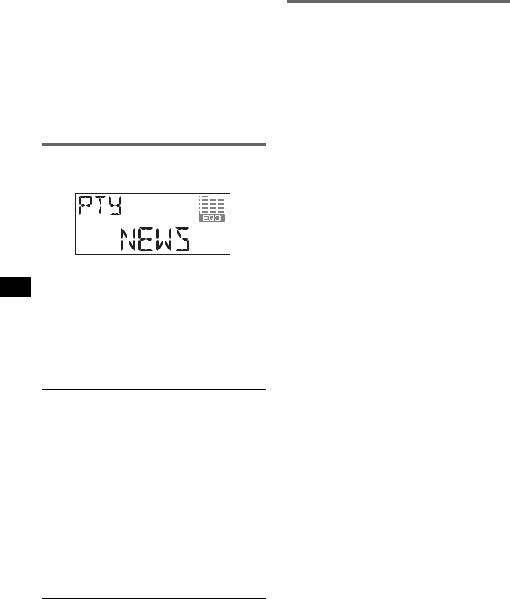
Local Link function (UK only)
This function enables you to select other local stations in the area, even if they are not stored on your number buttons.
1During FM reception, press a number button ((1) to (6)) on which a local station is stored.
2Within 5 seconds, press again a number button of the local station.
Repeat this procedure until the local station is received.
Selecting PTY
1 Press (PTY) during FM reception.
The current program type name appears if the station is transmitting PTY data.
2Press (PTY) repeatedly until the desired program type appears.
3Press (SEEK) –/+.
The unit starts to search for a station broadcasting the selected program type.
Type of programs
NEWS (News), AFFAIRS (Current Affairs), INFO (Information), SPORT (Sports), EDUCATE (Education), DRAMA (Drama), CULTURE (Culture), SCIENCE (Science), VARIED (Varied), POP M (Popular Music), ROCK M (Rock Music), EASY M (Easy Listening), LIGHT M (Light Classical), CLASSICS (Classical), OTHER M (Other Music Type), WEATHER (Weather), FINANCE (Finance), CHILDREN (Children’s Programs), SOCIAL A (Social Affairs), RELIGION (Religion), PHONE IN (Phone In), TRAVEL (Travel), LEISURE (Leisure), JAZZ (Jazz Music), COUNTRY (Country Music), NATION M (National Music), OLDIES (Oldies Music), FOLK M (Folk Music), DOCUMENT (Documentary)
Note
You cannot use this function in countries/regions where no PTY data is available.
Setting CT
1 Set “CT-ON” in setup (page 11).
Notes
•The CT function may not work even though an RDS station is being received.
•There might be a difference between the time set by the CT function and the actual time.
10
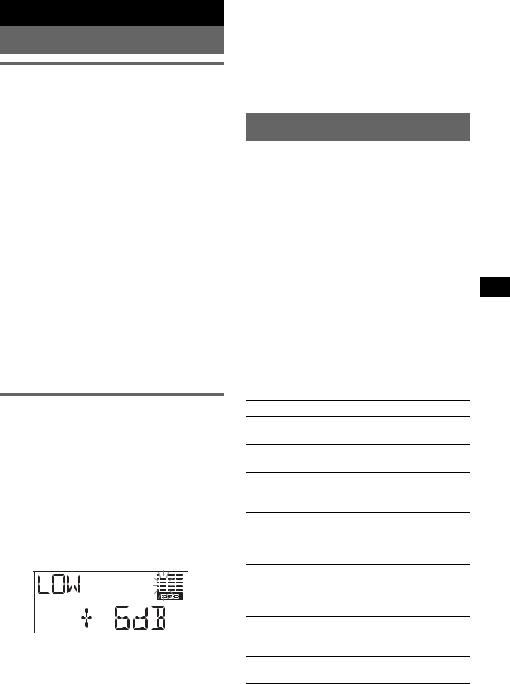
Other functions
Changing the sound settings
Adjusting the sound characteristics — BAL/FAD/SUB
You can adjust the balance, fader, and subwoofer volume.
1Press the select button repeatedly until “BAL,” “FAD” or “SUB” appears.
The item changes as follows:
LOW*1 t MID*1 t HI*1 t
BAL (left-right) t FAD (front-rear) t SUB (subwoofer volume)*2 t AUX*3
*1 When EQ3 is activated (page 11).
*2 When the audio output is set to “SUB” (page 11).
“ATT” is displayed at the lowest setting, and can be adjusted up to 20 steps.
*3 When AUX source is activated (page 12).
2Rotate the volume control dial to adjust the selected item.
After 3 seconds, the setting is complete and the display returns to normal play/reception mode.
With the card remote commander
In step 2, to adjust the selected item, press <, M, , or m.
Customizing the equalizer curve
— EQ3
“CUSTOM” of EQ3 allows you to make your own equalizer settings.
1Select a source, then press (EQ3) repeatedly to select “CUSTOM.”
2Press the select button repeatedly until “LOW,” “MID” or “HI” appears.
3Rotate the volume control dial to adjust the selected item.
The volume level is adjustable in 1 dB steps, from –10 dB to +10 dB.
Repeat steps 2 and 3 to adjust the equalizer curve.
To restore the factory-set equalizer curve, press and hold the select button before the setting is complete.
After 3 seconds, the setting is complete and the display returns to normal play/reception mode.
Tip
Other equalizer types are also adjustable.
With the card remote commander
In step 3, to adjust the selected item, press <, M, , or m.
Adjusting setup items — SET
1Press and hold the select button.
The setup display appears.
2Press the select button repeatedly until the desired item appears.
3Rotate the volume control dial to select the setting (example “ON” or “OFF”).
4Press and hold the select button.
The setup is complete and the display returns to normal play/reception mode.
Note
Displayed items will differ, depending on the source and setting.
With the card remote commander
In step 3, to select the setting, press < or ,.
The following items can be set (follow the page reference for details):
“z” indicates the default settings.
CLOCK-ADJ (Clock Adjust) (page 5)
CT (Clock Time)
To set “CT-ON” or “CT-OFF” (z) (page 9, 10).
BEEP
To set “BEEP-ON” (z) or “BEEP-OFF.”
AUX-A*1 (AUX Audio)
To turn the AUX source display “AUX-A-ON” (z) or “AUX-A-OFF” (page 12).
SUB/REAR*1
To switch the audio output.
–“SUB-OUT” (z): to output to a subwoofer.
–“REAR-OUT”: to output to a power amplifier.
DIM (Dimmer)
To change the brightness of the display.
–“DIM-ON”: to dim the display.
–“DIM-OFF” (z): to deactivate the dimmer.
ILM (Illumination)
To change the illumination color: “ILM-1” (z) or “ILM-2.”
DEMO*1 (Demonstration)
To set “DEMO-ON” (z) or “DEMO-OFF”.
continue to next page t
11
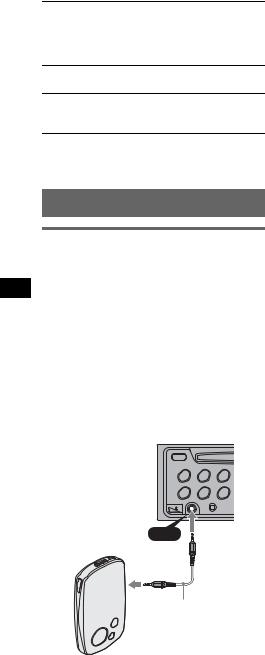
A.SCRL (Auto Scroll)
To scroll long displayed item automatically when the disc/group/track/album is changed.
–“A.SCRL-ON”: to scroll.
–“A.SCRL-OFF” (z): to not scroll.
REG*2 (Regional)
To set “REG-ON” (z) or “REG-OFF” (page 9).
LPF*3 (Low Pass Filter)
To select the subwoofer cut-off frequency: “LPF OFF” (z), “LPF125Hz” or “LPF 78Hz.”
*1 When the unit is turned off.
*2 When FM is received.
*3 When the audio output is set to “SUB.”
Using optional equipment
Auxiliary audio equipment
By connecting an optional portable audio device to the AUX input jack (stereo mini jack) on the unit and then simply selecting the source, you can listen on your car speakers. The volume level is adjustable for any difference between the unit and the portable audio device. Follow the procedure below:
Connecting the portable audio device
1Turn off the portable audio device.
2Turn down the volume on the unit.
3Connect to the unit.
AUX
Adjusting the volume level
Be sure to adjust the volume for each connected audio device before playback.
1Turn down the volume on the unit.
2Press (SOURCE) repeatedly until “AUX FRONT IN” appears.
3Start playback of the portable audio device at a moderate volume.
4Set your usual listening volume on the unit.
5Press the select button repeatedly until “AUX” appears, and rotate the volume control dial to adjust the volume level (-6 dB to +6 dB).
Connecting cord*
(not supplied)
* Be sure to use a straight type plug.
12
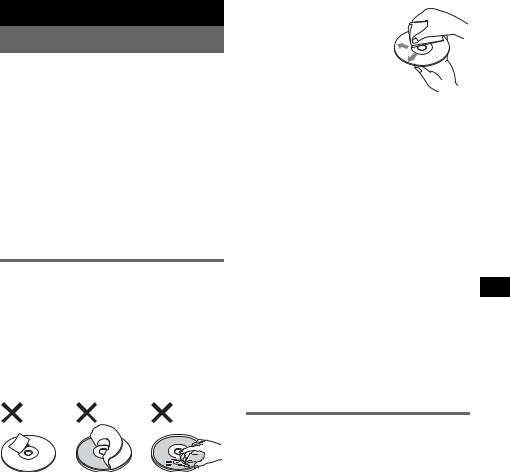
Additional Information
Precautions
•If your car has been parked in direct sunlight, allow the unit to cool off before operating it.
•Power antenna (aerial) will extend automatically while the unit is operating.
Moisture condensation
On a rainy day or in a very damp area, moisture condensation may occur inside the lenses and display of the unit. Should this occur, the unit will not operate properly. In such a case, remove the disc and wait for about an hour until the moisture has evaporated.
To maintain high sound quality
Be careful not to splash juice or other soft drinks onto the unit or discs.
Notes on discs
•To keep a disc clean, do not touch its surface. Handle the disc by its edge.
•Keep your discs in their cases or disc magazines when not in use.
•Do not subject discs to heat/high temperature. Avoid leaving them in a parked car or on a dashboard/rear tray.
•Do not attach labels, or use discs with sticky ink/ residue. Such discs may stop spinning when used, causing a malfunction, or may ruin the disc.
•Before playing, clean the discs with a commercially available cleaning cloth. Wipe each disc
from the center out. Do not use solvents such as benzine, thinner, commercially available cleaners, or antistatic spray intended for analog discs.
Notes on CD-R/CD-RW discs
•Some CD-Rs/CD-RWs (depending on the equipment used for its recording or the condition of the disc) may not play on this unit.
•You cannot play a CD-R/a CD-RW that is not finalized.
Music discs encoded with copyright protection technologies
This product is designed to play back discs that conform to the Compact Disc (CD) standard. Recently, various music discs encoded with copyright protection technologies are marketed by some record companies. Please be aware that among those discs, there are some that do not conform to the CD standard and may not be playable by this product.
Note on DualDiscs
A DualDisc is a two sided disc product which mates DVD recorded material on one side with digital audio material on the other side. However, since the audio material side does not conform to the Compact Disc (CD) standard, playback on this product is not guaranteed.
•Do not use any discs with labels or stickers attached.
The following malfunctions may result from using such discs:
–Inability to eject a disc (due to a label or sticker peeling off and jamming the eject mechanism).
–Inability to read audio data correctly (e.g., playback skipping, or no playback) due to heat shrinking of a sticker or label causing a disc to warp.
•Discs with non-standard shapes (e.g., heart, square, star) cannot be played on this unit. Attempting to do so may damage the unit. Do not use such discs.
•You cannot play 8 cm (3 1/4 in) CDs.
About MP3/WMA files
MP3, which stands for MPEG-1 Audio Layer-3, is a music file compression format standard. It compresses audio CD data to approximately 1/10 of its original size.
WMA, which stands for Windows Media Audio, is another music file compression format standard. It compresses audio CD data to approximately 1/22* of its original size.
* only for 64 kbps
•The unit is compatible with the ISO 9660 level 1/ level 2 format, Joliet/Romeo in the expansion format and Multi Session.
•The maximum number of:
–folders (albums): 150 (including root and empty folders).
–MP3/WMA files (tracks) and folders contained in a disc: 300 (if a folder/file names contain many characters, this number may become less than 300).
–displayable characters for a folder/file name is 32 (Joliet), or 64 (Romeo).
continue to next page t
13
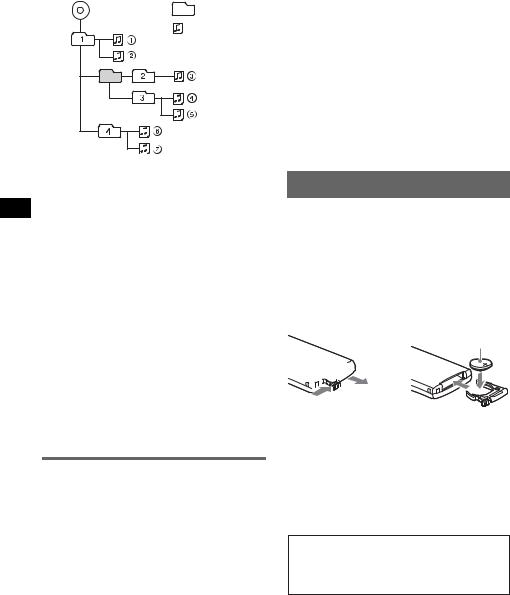
•ID3 tag versions 1.0, 1.1, 2.2, 2.3 and 2.4 apply to MP3 only. ID3 tag is 15/30 characters (1.0 and 1.1), or 63/126 characters (2.2, 2.3 and 2.4). WMA tag is 63 characters.
Playback order of MP3/WMA files
MP3/WMA |
Folder |
|
(album) |
||
|
||
|
MP3/WMA |
|
|
file (track) |
Notes
•When naming an MP3 file/WMA file, be sure to add the file expansion “.mp3” / “.wma” to the file name.
•During playback of a VBR (variable bit rate) MP3/ WMA file or fast-forward/reverse, elapsed playing time may not display accurately.
•When the disc is recorded in Multi Session, only the first track of the first session format is recognized and played (any other format is skipped). The priority of the format is CD-DA, ATRAC CD and MP3/WMA.
–When the first track is a CD-DA, only CD-DA of the first session is played.
–When the first track is not a CD-DA, an ATRAC CD or MP3/WMA session is played. If the disc has no data in any of these formats, “NO MUSIC” is displayed.
Notes on MP3
•Be sure to finalize the disc before using on the unit.
•If you play a high-bit-rate MP3, such as 320 kbps, sound may be intermittent.
Notes on WMA
•Files made with lossless compression are not playable.
•Files protected by copyright are not playable.
About ATRAC CD
ATRAC3plus format
ATRAC3, which stands for Adaptive Transform Acoustic Coding3, is audio compression technology. It compresses audio CD data to approximately 1/10 of its original size. ATRAC3plus, which is an extended format of ATRAC3, compresses the audio CD data to approximately 1/20 of its original size. The unit accepts both ATRAC3 and ATRAC3plus format.
ATRAC CD
ATRAC CD is recorded audio CD data which is compressed to ATRAC3 or ATRAC3plus format using authorized software, such as SonicStage 2.0 or later, or SonicStage Simple Burner.
•The maximum number of:
–folders (groups): 255
–files (tracks): 999
•The characters for a folder/file name and text information written by SonicStage are displayed.
For details on ATRAC CD, see the SonicStage or SonicStage Simple Burner manual.
Note
Be sure to create the ATRAC CD using authorized software, such as SonicStage 2.0 or later, or SonicStage Simple Burner 1.0 or 1.1.
If you have any questions or problems concerning your unit that are not covered in this manual, consult your nearest Sony dealer.
Maintenance
Replacing the lithium battery of the card remote commander
Under normal conditions, the battery will last approximately 1 year. (The service life may be shorter, depending on the conditions of use.)
When the battery becomes weak, the range of the card remote commander becomes shorter. Replace the battery with a new CR2025 lithium battery. Use of any other battery may present a risk of fire or explosion.
+ side up


 2 c
2 c
1
Notes on the lithium battery
•Keep the lithium battery out of the reach of children. Should the battery be swallowed, immediately consult a doctor.
•Wipe the battery with a dry cloth to assure a good contact.
•Be sure to observe the correct polarity when installing the battery.
•Do not hold the battery with metallic tweezers, otherwise a short-circuit may occur.
WARNING
Battery may explode if mistreated.
Do not recharge, disassemble, or dispose of in fire.
14
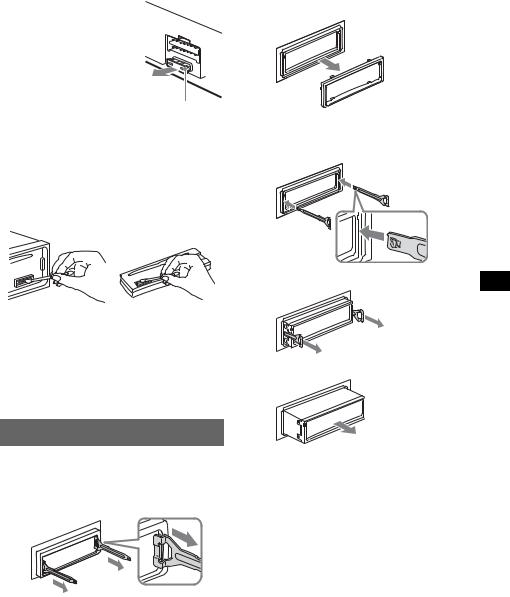
Fuse replacement |
|
3Pull out the release keys to remove the |
|
When replacing the fuse, be |
|
protection collar. |
|
sure to use one matching the |
|
|
|
amperage rating stated on the |
|
|
|
original fuse. If the fuse blows, |
|
|
|
check the power connection and |
|
|
|
replace the fuse. If the fuse |
|
|
|
blows again after replacement, |
|
|
|
there may be an internal |
|
|
|
malfunction. In such a case, |
Fuse (10A) |
|
|
consult your nearest Sony |
2 Remove the unit. |
||
|
|||
dealer. |
|
||
Cleaning the connectors |
|
1Insert both release keys simultaneously |
|
|
until they click. |
||
The unit may not function properly if the connectors |
|
||
between the unit and the front panel are not clean. In |
|
||
order to prevent this, detach the front panel (page 5) |
Hook facing |
||
and clean the connectors with a cotton swab. Do not |
|||
inwards. |
|||
apply too much force. Otherwise, the connectors may be damaged.
2Pull the release keys to unseat the unit.
Main unit |
Back of the front |
|
panel |
Notes
•For safety, turn off the ignition before cleaning the connectors, and remove the key from the ignition switch.
•Never touch the connectors directly with your fingers or with any metal device.
3Slide the unit out of the mounting.
Removing the unit
1Remove the protection collar.
1Detach the front panel (page 5).
2Engage the release keys together with the protection collar.
Orient the release keys as shown.
15

Specifications
CD Player section
Signal-to-noise ratio: 120 dB Frequency response: 10 – 20,000 Hz
Wow and flutter: Below measurable limit
Tuner section
FM
Tuning range: 87.5 – 108.0 MHz
Antenna (aerial) terminal:
External antenna (aerial) connector
Intermediate frequency: 10.7 MHz/450 kHz Usable sensitivity: 9 dBf
Selectivity: 75 dB at 400 kHz
Signal-to-noise ratio: 67 dB (stereo), 69 dB (mono)
Harmonic distortion at 1 kHz: 0.5 % (stereo), 0.3 % (mono)
Separation: 35 dB at 1 kHz Frequency response: 30 – 15,000 Hz
MW/LW
Tuning range:
MW: 531 – 1,602 kHz LW: 153 – 279 kHz
Antenna (aerial) terminal:
External antenna (aerial) connector
Intermediate frequency: 10.7 MHz/450 kHz
Sensitivity: MW: 30 µV, LW: 40 µV
Power amplifier section
Outputs: Speaker outputs (sure seal connectors)
Speaker impedance: 4 – 8 ohms
Maximum power output: 50 W × 4 (at 4 ohms)
General
Outputs:
Audio outputs terminal (sub/rear switchable) Power antenna (aerial) relay control terminal Power amplifier control terminal
Inputs:
Telephone ATT control terminal Antenna (aerial) input terminal AUX input jack (stereo mini jack)
Tone controls:
Low: ±10 dB at 60 Hz (XPLOD)
Mid: ±10 dB at 1 kHz (XPLOD)
High: ±10 dB at 10 kHz (XPLOD)
Power requirements: 12 V DC car battery (negative ground (earth))
Dimensions: Approx. 178 × 50 × 178 mm (7 1/8 × 2 × 7 1/8 in) (w/h/d)
Mounting dimensions: Approx. 182 × 53 × 162 mm (7 1/4 × 2 1/8 × 6 1/2 in) (w/h/d)
Mass: Approx. 1.2 kg (2 lb 11 oz)
Supplied accessories:
Card remote commander: RM-X151
Parts for installation and connections (1 set)
Your dealer may not handle some of the above listed accessories. Please ask the dealer for detailed information.
MPEG Layer-3 audio coding technology and patents licensed from Fraunhofer IIS and Thomson.
Design and specifications are subject to change without notice.
•Halogenated flame retardants are not used in the certain printed wiring boards.
•Halogenated flame retardants are not used in cabinets.
•Paper is used for the packaging cushions.
•VOC (Volatile Organic Compound)-free vegetable oil based ink is used for printing the carton.
Troubleshooting
The following checklist will help you remedy problems you may encounter with your unit. Before going through the checklist below, check the connection and operating procedures.
General
No power is being supplied to the unit.
•Check the connection. If everything is in order, check the fuse.
•If the unit is turned off and the display disappears, it cannot be operated with the remote commander. t Turn on the unit.
The power antenna (aerial) does not extend.
The power antenna (aerial) does not have a relay box.
No sound.
•The volume is too low.
•The ATT function is activated (page 7), or the Telephone ATT function (when the interface cable of a car telephone is connected to the ATT lead) is activated.
•The position of the fader control “FAD” is not set for a 2-speaker system.
No beep sound.
•The beep sound is canceled (page 11).
•An optional power amplifier is connected and you are not using the built-in amplifier.
The contents of the memory have been erased.
•The RESET button has been pressed. t Store again into the memory.
•The power supply lead or battery has been disconnected.
•The power supply lead is not connected properly.
Stored stations and correct time are erased. The fuse has blown.
Makes noise when the position of the ignition is switched.
The leads are not matched correctly with the car’s accessory power connector.
US and foreign patents licensed from Dolby 16 Laboratories.
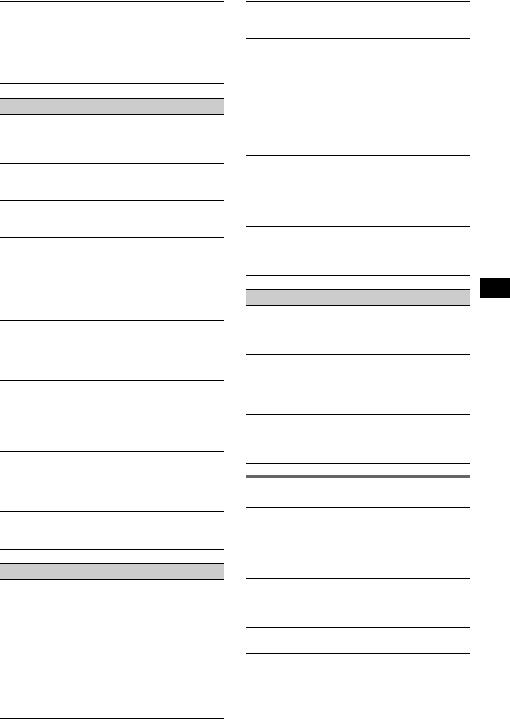
The display disappears from/does not appear in the display window.
•The dimmer is set “DIM-ON” (page 11).
•The display disappears if you press and hold (OFF).
tPress and hold (OFF) on the unit until the display appears.
•The connectors are dirty (page 15).
CD playback
The disc cannot be loaded.
•Another disc is already loaded.
•The disc has been forcibly inserted upside down or in the wrong way.
The disc does not playback.
•Defective or dirty disc.
•The CD-Rs/CD-RWs are not for audio use (page 13).
MP3/WMA files cannot be played back.
The disc is incompatible with the MP3/WMA format and version (page 13).
MP3/WMA files take longer to play back than others.
The following discs take a longer time to start playback.
–a disc recorded with a complicated tree structure.
–a disc recorded in Multi Session.
–a disc to which data can be added.
The ATRAC CD cannot play.
•The disc is not created by authorized software, such as SonicStage or SonicStage Simple Burner.
•Tracks that are not included in the group cannot be played.
The display items do not scroll.
•For discs with very many characters, those may not scroll.
•“A.SCRL” is set to “OFF”.
tSet “A.SCRL-ON” (page 12) or press (SCRL) on the card remote commander.
The sound skips.
• Installation is not correct.
tInstall the unit at an angle of less than 45° in a sturdy part of the car.
•Defective or dirty disc.
The operation buttons do not function. The disc will not eject.
Press the RESET button (page 4).
Radio reception
The stations cannot be received.
The sound is hampered by noises.
•Connect a power antenna (aerial) control lead (blue) or accessory power supply lead (red) to the power supply lead of a car’s antenna (aerial) booster (only when your car has built-in FM/MW/LW antenna (aerial) in the rear/side glass).
•Check the connection of the car antenna (aerial).
•The auto antenna (aerial) will not go up.
tCheck the connection of the power antenna (aerial) control lead.
•Check the frequency.
Preset tuning is not possible.
•Store the correct frequency in the memory.
•The broadcast signal is too weak.
Automatic tuning is not possible.
•Setting of the local seek mode is not correct. t Tuning stops too frequently:
Press (SENS) until “LOCAL-ON” appears.
tTuning does not stop at a station:
Press (SENS) repeatedly until “MONO-ON” or “MONO-OFF” (FM), or “LOCAL-OFF” (MW/ LW) appears.
•The broadcast signal is too weak.
tPerform manual tuning.
During FM reception, the “ST” indication flashes.
•Tune in the frequency accurately.
•The broadcast signal is too weak.
tPress (SENS) to set the monaural reception mode to “MONO-ON.”
An FM program broadcast in stereo is heard in monaural.
The unit is in monaural reception mode.
t Press (SENS) until “MONO-OFF” appears.
RDS
The SEEK starts after a few seconds of listening.
The station is non-TP or has weak signal. t Deactivate TA (page 9).
No traffic announcements.
•Activate TA (page 9).
•The station does not broadcast any traffic announcements despite being TP.
t Tune in another station.
PTY displays “- - - - - - - -.”
•The current station is not an RDS station.
•RDS data has not been received.
•The station does not specify the program type.
Error displays/Messages
ERROR
•The disc is dirty or inserted upside down. t Clean or insert the disc correctly.
•A blank disc has been inserted.
•The disc cannot play because of some problem. t Insert another disc.
FAILURE
The connection of speaker/amplifier is incorrect.
tSee the installation guide manual of this model to check the connection.
L.SEEK +/–
The local seek mode is on during automatic tuning.
continue to next page t
17

NO AF
There is no alternative frequency for the current station.
tPress (SEEK) –/+ while the program service name is flashing. The unit starts searching for another frequency with the same PI (Program Identification) data (“PI SEEK” appears).
NO ID3
ID3 tag information is not written in the MP3 file.
NO INFO
Text information is not written in the ATRAC3/ ATRAC3plus or WMA file.
NO MUSIC
The disc is not a music file. t Insert a music CD.
NO NAME
A track/album/group/disc name is not written in the track.
NO TP
The unit will continue searching for available TP stations.
OFFSET
There may be an internal malfunction.
tCheck the connection. If the error indication remains on in the display, consult your nearest Sony dealer.
READ
The unit is reading all track and group information on the disc.
tWait until reading is complete and playback starts automatically. Depending on the disc structure, it may take more than a minute.
RESET
The unit cannot be operated due to a problem. t Press the RESET button (page 4).
“


 ” or “
” or “ 


 ”
”
During reverse or fast-forward, you have reached the beginning or the end of the disc and you cannot go any further.
“ ”
”
The character cannot be displayed with the unit.
If these solutions do not help improve the situation, consult your nearest Sony dealer.
If you take the unit to be repaired because of CD playback trouble, bring the disc that was used at the time the problem began.
18
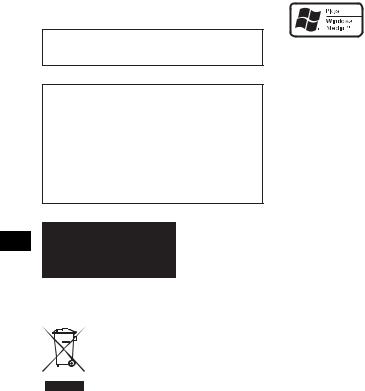
Wichtig!
Bitte nehmen Sie sich etwas Zeit, um den Geräte-Pass vollständig auszufüllen. Dieser befindet sich auf der hinteren Umschlagseite dieser Bedienungsanleitung.
Zur Installation und zum Anschluss siehe die mitgelieferte Installations-/Anschlussanleitung.
Warnhinweis, wenn die Zündung Ihres Fahrzeugs nicht über eine Zubehörposition (ACC oder I) verfügt
Nachdem Sie die Zündung ausgeschaltet haben, halten Sie am Gerät unbedingt (OFF) gedrückt, bis die Anzeige ausgeblendet wird. Andernfalls wird die Anzeige nicht ausgeschaltet und der Autobatterie wird Strom entzogen.
Dieses Etikett befindet sich an der Unterseite des Gehäuses.
Entsorgung von gebrauchten elektrischen und elektronischen Geräten (anzuwenden in den Ländern der Europäischen Union und anderen europäischen Ländern mit einem separaten Sammelsystem für diese Geräte)
Das Symbol auf dem Produkt oder seiner Verpackung weist darauf hin, dass dieses Produkt nicht als normaler Haushaltsabfall zu behandeln ist, sondern an einer Annahmestelle für das Recycling von elektrischen und elektronischen Geräten abgegeben werden muss. Durch Ihren Beitrag zum korrekten Entsorgen dieses Produkts schützen Sie die Umwelt und die Gesundheit Ihrer Mitmenschen. Umwelt und Gesundheit werden durch falsches Entsorgen gefährdet. Materialrecycling hilft, den Verbrauch von Rohstoffen zu verringern. Weitere Informationen über das Recycling dieses Produkts erhalten Sie von Ihrer Gemeinde, den kommunalen Entsorgungsbetrieben oder dem Geschäft, in dem Sie das Produkt gekauft haben.
Geeignetes Zubehör: Fernbedienung
SonicStage und das entsprechende Logo sind Markenzeichen der Sony Corporation. ATRAC, ATRAC3, ATRAC3plus und die entsprechenden Logos sind Markenzeichen der Sony Corporation.
Microsoft, Windows Media und das Windows-Logo sind
Markenzeichen oder eingetragene Markenzeichen
der Microsoft Corporation in den USA und/oder anderen Ländern.
2

Inhalt
Willkommen!. . . . . . . . . . . . . . . . . . . . . . . . . . . 4
Vorbereitungen
Zurücksetzen des Geräts . . . . . . . . . . . . . . . . . . 4 Vorbereiten der Kartenfernbedienung . . . . . . . . 4 Einstellen der Uhr . . . . . . . . . . . . . . . . . . . . . . . 5 Abnehmen der Frontplatte . . . . . . . . . . . . . . . . . 5 Anbringen der Frontplatte. . . . . . . . . . . . . . . 5
Lage und Grundfunktionen der Teile und Bedienelemente
Hauptgerät. . . . . . . . . . . . . . . . . . . . . . . . . . . 6
Kartenfernbedienung RM-X151 . . . . . . . . . . 6
CD
Informationen im Display . . . . . . . . . . . . . . . 8 Repeat und Shuffle Play . . . . . . . . . . . . . . . . 8
Radio
Speichern und Empfangen von Sendern . . . . . . 9 Automatisches Speichern von Sendern
— BTM. . . . . . . . . . . . . . . . . . . . . . . . . . . . . 9 Manuelles Speichern von Sendern . . . . . . . . 9 Empfangen gespeicherter Sender . . . . . . . . . 9 Automatisches Einstellen von Sendern. . . . . 9 RDS . . . . . . . . . . . . . . . . . . . . . . . . . . . . . . . . . . 9 Übersicht . . . . . . . . . . . . . . . . . . . . . . . . . . . . 9 Einstellen von AF und TA . . . . . . . . . . . . . 10 Auswählen des Programmtyps (PTY) . . . . 11 Einstellen der Uhrzeit (CT). . . . . . . . . . . . . 11
Weitere Funktionen
Ändern der Klangeinstellungen . . . . . . . . . . . 12 Einstellen der Klangeigenschaften
— BAL/FAD/SUB. . . . . . . . . . . . . . . . . . . 12 Individuelles Einstellen der Equalizer-Kurve
— EQ3 . . . . . . . . . . . . . . . . . . . . . . . . . . . . 12 Einstellen von Konfigurationsoptionen
— SET . . . . . . . . . . . . . . . . . . . . . . . . . . . . . . 12 Verwenden gesondert erhältlicher Geräte. . . . 13 Zusätzliche Audiogeräte. . . . . . . . . . . . . . . 13
Weitere Informationen
Sicherheitsmaßnahmen . . . . . . . . . . . . . . . . . . 14 Hinweise zu CDs . . . . . . . . . . . . . . . . . . . . 14 MP3-/WMA-Dateien . . . . . . . . . . . . . . . . . 15 ATRAC-CDs . . . . . . . . . . . . . . . . . . . . . . . 16 Wartung . . . . . . . . . . . . . . . . . . . . . . . . . . . . . 16 Ausbauen des Geräts. . . . . . . . . . . . . . . . . . . . 17 Technische Daten . . . . . . . . . . . . . . . . . . . . . . 18 Störungsbehebung. . . . . . . . . . . . . . . . . . . . . . 18 Fehleranzeigen/Meldungen . . . . . . . . . . . . 20
3
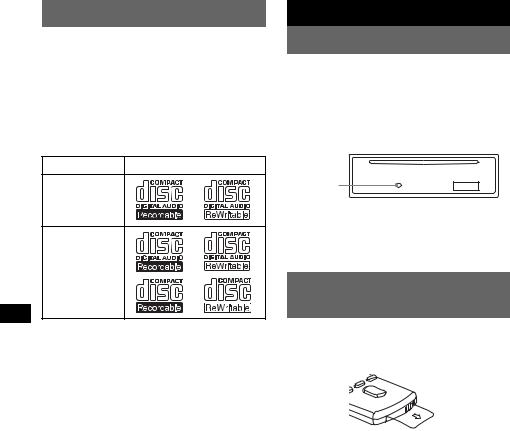
Willkommen!
Danke, dass Sie sich für diesen CD-Player von Sony entschieden haben. Mit diesem Gerät stehen Ihnen im Auto die folgenden Funktionen zur Verfügung.
•CD-Wiedergabe
Wiedergabe von CD-DAs (auch solche mit CD TEXT*), CD-Rs/CD-RWs (MP3-/WMA- Dateien, auch auf Multisession-CDs (Seite 15)) sowie ATRAC-CDs (ATRAC3und ATRAC3plus-Format (Seite 16)).
CD-Typ |
Beschriftung auf der CD |
CD-DA
MP3
WMA
ATRAC-CD
•Radioempfang
–Für jeden Frequenzbereich (FM1 (UKW1), FM2 (UKW2), FM3 (UKW3), MW und LW) können Sie bis zu 6 Sender speichern.
–BTM (Speicherbelegungsautomatik): Das Gerät wählt die Sender mit den stärksten Signalen aus und speichert diese.
•RDS-Funktionen
–Sie können die RDS-Dienste von UKWSendern nutzen, die RDS-Signale (Radiodatensystem) ausstrahlen.
•Klangeinstellungen
–EQ3: Sie können für 7 Musiktypen eine spezielle Equalizer-Kurve auswählen.
•Anschließen eines zusätzlichen Geräts
–An die AUX-Eingangsbuchse an der Vorderseite des Geräts können Sie ein tragbares Audiogerät anschließen.
*Eine CD mit CD TEXT ist eine CD-DA, die Informationen wie den Namen der CD, den Namen des Interpreten und die Namen der Titel enthält.
Vorbereitungen
Zurücksetzen des Geräts
Bevor Sie das Gerät zum ersten Mal benutzen oder wenn Sie die Autobatterie ausgetauscht oder die Verbindungen gewechselt haben, müssen Sie das Gerät zurücksetzen.
Nehmen Sie die Frontplatte ab und drücken Sie die Taste RESET mit einem spitzen Gegenstand, wie z. B. einem Kugelschreiber.
Taste
RESET
Hinweis
Wenn Sie die Taste RESET drücken, werden die eingestellte Uhrzeit und einige weitere gespeicherte Einstellungen gelöscht.
Vorbereiten der
Kartenfernbedienung
Bevor Sie die Kartenfernbedienung zum ersten Mal verwenden, müssen Sie die Isolierfolie herausziehen.
4
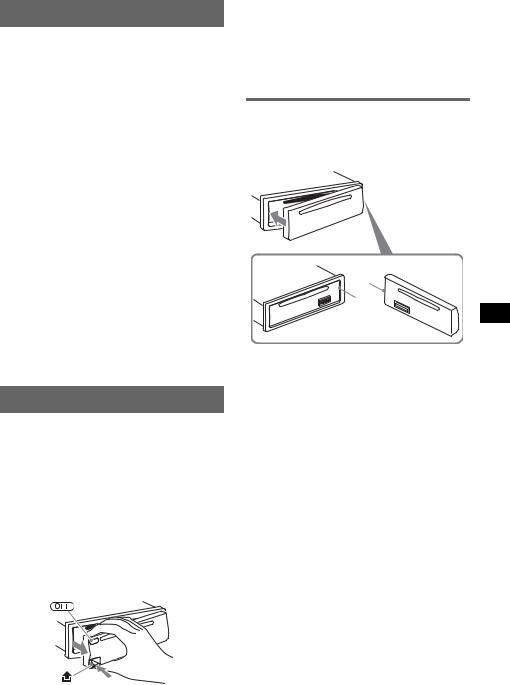
Einstellen der Uhr
Die Uhr zeigt die Uhrzeit im 24-Stunden-Format digital an.
1Halten Sie die Auswahltaste gedrückt.
Die Einstellanzeige erscheint.
2Drücken Sie die Auswahltaste so oft, bis „CLOCK-ADJ“ angezeigt wird.
3Drücken Sie (DSPL).
Die Stundenanzeige blinkt.
4Drehen Sie den Lautstärkeregler, um die Stunden und Minuten einzustellen.
Drücken Sie (DSPL), um zur jeweils nächsten Ziffer in der Digitalanzeige zu wechseln.
5Drücken Sie die Auswahltaste.
Der Einstellvorgang ist damit abgeschlossen und die Uhr beginnt zu laufen.
Zum Einblenden der Uhrzeit drücken Sie (DSPL). Drücken Sie (DSPL) erneut, um zur vorherigen Anzeige zurückzuschalten.
Tipp
Mithilfe der RDS-Funktion können Sie die Uhr auch automatisch einstellen lassen (Seite 11).
Mit der Kartenfernbedienung
Stellen Sie in Schritt 4 die Stunden und Minuten mit M oder m ein.
Abnehmen der Frontplatte
Um zu verhindern, dass das Gerät gestohlen wird, können Sie die Frontplatte abnehmen.
Warnton
Wenn Sie den Zündschlüssel in die Position OFF stellen, ohne die Frontplatte abzunehmen, ertönt einige Sekunden lang ein Warnton.
Der Warnton wird nur ausgegeben, wenn der integrierte Verstärker verwendet wird.
1Drücken Sie (OFF).
Das Gerät schaltet sich aus.
2Drücken Sie  und ziehen Sie die Frontplatte auf sich zu und heraus.
und ziehen Sie die Frontplatte auf sich zu und heraus.
Hinweise
•Lassen Sie die Frontplatte nicht fallen und drücken Sie nicht zu stark auf die Frontplatte und das Display.
•Schützen Sie die Frontplatte vor Hitze bzw. hohen Temperaturen und vor Feuchtigkeit. Lassen Sie sie in geparkten Autos nicht auf dem Armaturenbrett oder auf der Hutablage liegen.
Anbringen der Frontplatte
Setzen Sie Teil A der Frontplatte wie abgebildet an Teil B am Gerät an und drücken Sie dann die linke Seite hinein, bis sie mit einem Klicken einrastet.
A
B
Hinweis
Legen Sie auf der Innenseite der Frontplatte nichts ab.
5

Lage und Grundfunktionen der Teile und Bedienelemente
Hauptgerät
Kartenfernbedienung RM-X151
OFF |
ATT |
SOURCE SEL MODE
+
–
DSPL |
|
SCRL |
1 |
2 |
3 |
4 |
5 |
6 |
+
 VOL
VOL
–
CDX-A360
Näheres finden Sie auf den angegebenen Seiten. Die entsprechenden Tasten auf der Kartenfernbedienung haben dieselbe Funktion wie die Tasten am Gerät.
ATaste OFF
Ausschalten bzw. Stoppen der Tonquelle.
B Zahlentasten (Stationstasten)
CD:
(1)/(2): GP*1/ALBM*2 –/+
Überspringen von Gruppen/Alben (drücken) bzw. Überspringen mehrerer Gruppen/Alben hintereinander (gedrückt halten).
(3): REP 8
(4): SHUF 8
(6): PAUSE
Anhalten der Wiedergabe. Zum Beenden der Funktion drücken Sie die Taste erneut.
Radio:
Einstellen gespeicherter Sender (drücken) bzw. Speichern von Sendern (gedrückt halten).
CTaste AF (Alternativfrequenzen)/TA (Verkehrsdurchsagen) 10
Einstellen von AF und TA bei einem RDS-
Sender.
D Taste PTY (Programmtyp) 11
Auswählen von PTY bei einem RDS-Sender.
6

ETasten SEEK –/+
CD:
Überspringen von Titeln (drücken), Überspringen mehrerer Titel hintereinander (drücken, dann innerhalb von 1 Sekunde erneut drücken und gedrückt halten) bzw. Rückwärts-/Vorwärtssuchen in einem Titel (gedrückt halten).
Radio:
Automatisches Einstellen von Sendern (drücken) bzw. manuelle Sendersuche (gedrückt halten).
FCD-Einschub
Legen Sie hier eine CD ein (mit der beschrifteten Seite nach oben). Die Wiedergabe beginnt automatisch.
GTaste Z (Auswerfen)
Auswerfen der CD.
H Taste  (Lösen der Frontplatte) 5
(Lösen der Frontplatte) 5
IAUX-Eingangsbuchse 13
Anschließen eines tragbaren Audiogeräts.
JEmpfänger für die Kartenfernbedienung
K Taste RESET (hinter der Frontplatte) 4
LTaste SENS/BTM
Verbessern des Empfangs: LOCAL/MONO (drücken) bzw. Starten der BTM-Funktion (gedrückt halten).
MTaste EQ3 (Equalizer) 12
Auswählen eines Equalizer-Typs (XPLOD, VOCAL, CLUB, JAZZ, NEW AGE, ROCK, CUSTOM oder OFF).
NTaste SOURCE
Einschalten bzw. Wechseln der Tonquelle (Radio/CD/AUX).
OLautstärkeregler/Auswahltaste 12
Einstellen der Lautstärke (drehen) bzw. Auswählen von Einstelloptionen (drücken und drehen).
PTaste MODE 9
Auswählen des Radiofrequenzbereichs (FM (UKW)/MW/LW).
QTaste DSPL (Anzeige)/DIM (Dimmer)
5, 8
Wechseln der angezeigten Informationen (drücken) bzw. Ändern der Helligkeit im Display (gedrückt halten).
R Display
Die folgenden Tasten auf der Kartenfernbedienung unterscheiden sich außerdem hinsichtlich ihres Namens bzw. ihrer Funktion von denen am Gerät. Ziehen Sie vor dem Gebrauch die Isolierfolie heraus (Seite 4).
ql Tasten < (.)/, (>)
Beim Steuern von CDund RadioFunktionen entsprechen diese Tasten den Tasten (SEEK) –/+ am Gerät.
w; Lautstärketaste VOL +/–
Einstellen der Lautstärke.
wa Taste ATT (Dämpfen des Tons)
Dämpfen des Tons. Zum Beenden der Funktion drücken Sie die Taste erneut.
ws Taste SEL (Auswählen)
Auswählen von Optionen.
wd Tasten M (+)/m (–)
Beim Steuern von CD-Funktionen entsprechen diese Tasten den Tasten
(1)/(2) –/+ am Gerät.
wf Bildlauftaste SCRL 8
Hiermit lassen Sie die Informationen im Display durchlaufen.
wg Zahlentasten (Stationstasten)
Einstellen gespeicherter Sender (drücken) bzw. Speichern von Sendern (gedrückt halten).
*1 Bei Wiedergabe einer ATRAC-CD.
*2 Bei Wiedergabe einer MP3-/WMA-Datei.
Hinweis
Wenn Sie das Gerät ausschalten und die Anzeige ausgeblendet ist, können Sie es nicht mit der Kartenfernbedienung bedienen. Drücken Sie zunächst (SOURCE) am Gerät oder legen Sie eine CD ein, um das Gerät zu aktivieren.
Tipp
Einzelheiten zum Austauschen der Batterie finden Sie unter „Austauschen der Lithiumbatterie der Kartenfernbedienung“ auf Seite 16.
7

CD
Informationen im Display
A Tonquelle
B WMA-/MP3-/ATRAC-CD-Anzeige
CTitelnummer/Verstrichene Spieldauer, CD-/ Interpretenname, Album-/Gruppennummer*1, Album-/Gruppenname, Titelname, Textinformationen*2, Uhrzeit
*1 Die Album-/Gruppennummer wird nur beim Wechseln des Albums bzw. der Gruppe angezeigt.
*2 Bei der Wiedergabe einer MP3-Datei wird das ID3Tag angezeigt, bei der Wiedergabe einer ATRACCD werden mit SonicStage usw. eingegebene Textinformationen angezeigt und bei der Wiedergabe einer WMA-Datei wird das WMA-Tag angezeigt.
Zum Wechseln der Informationen im Display C drücken Sie (DSPL). Damit die Informationen im Display C durchlaufen, drücken Sie (SCRL) auf der Kartenfernbedienung oder stellen „A.SCRL-ON“ ein (Seite 13).
Tipp
Je nach CD-Typ, Aufnahmeformat und Einstellungen werden unterschiedliche Informationen angezeigt. Erläuterungen zu MP3/WMA finden Sie auf Seite 15, Erläuterungen zu ATRAC-CDs finden Sie auf Seite 16.
Repeat und Shuffle Play
1Drücken Sie während der Wiedergabe so oft (3) (REP) oder (4) (SHUF), bis die gewünschte Einstellung im Display angezeigt wird.
Einstellung |
Funktion |
REP-TRACK |
Wiederholtes |
|
Wiedergeben eines |
|
Titels. |
|
|
REP-ALBM*1 |
Wiederholtes |
|
Wiedergeben eines |
|
Albums. |
|
|
REP-GP*2 |
Wiederholtes |
|
Wiedergeben einer |
|
Gruppe. |
|
|
SHUF-ALBM*1 |
Wiedergeben eines |
|
Albums in willkürlicher |
|
Reihenfolge. |
|
|
SHUF-GP*2 |
Wiedergeben einer |
|
Gruppe in willkürlicher |
|
Reihenfolge. |
|
|
SHUF-DISC |
Wiedergeben einer CD |
|
in willkürlicher |
|
Reihenfolge. |
|
|
*1 Bei Wiedergabe einer MP3-/WMA-Datei.
*2 Bei Wiedergabe einer ATRAC-CD.
Wenn Sie wieder in den normalen Wiedergabemodus wechseln möchten, wählen Sie „REP-OFF“ bzw. „SHUF-OFF“.
8
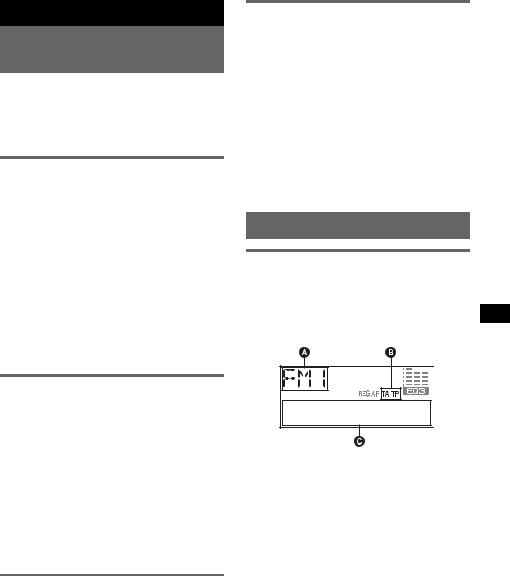
Radio
Speichern und Empfangen von Sendern
Achtung
Wenn Sie während der Fahrt Sender einstellen, sollten Sie die BTM-Funktion (Speicherbelegungsautomatik) verwenden. Andernfalls besteht Unfallgefahr.
Automatisches Speichern von Sendern — BTM
1Drücken Sie (SOURCE) so oft, bis
„TUNER“ angezeigt wird.
Zum Wechseln des Frequenzbereichs drücken Sie mehrmals (MODE). Sie können zwischen FM1 (UKW1), FM2 (UKW2), FM3 (UKW3), MW und LW wählen.
2Halten Sie (SENS/BTM) gedrückt, bis
„BTM“ blinkt.
Das Gerät speichert die Sender in der Reihenfolge der Frequenzen auf den Zahlentasten (Stationstasten).
Ein Signalton ist zu hören und die Einstellung wird gespeichert.
Manuelles Speichern von Sendern
1Während des Empfangs des zu speichernden Senders halten Sie eine Stationstaste ((1) bis (6)) so lange gedrückt, bis „MEM“ angezeigt wird.
Die Stationstastenanzeige wird im Display angezeigt.
Hinweis
Wenn Sie auf der gleichen Stationstaste einen anderen Sender speichern, wird der zuvor gespeicherte Sender ersetzt.
Tipp
Wenn ein RDS-Sender gespeichert wird, wird auch die AF/TA-Einstellung gespeichert (Seite 10).
Empfangen gespeicherter Sender
1Wählen Sie den Frequenzbereich aus und drücken Sie eine Stationstaste ((1) bis (6)).
Automatisches Einstellen von Sendern
1Wählen Sie den Frequenzbereich aus und starten Sie mit (SEEK) –/+ die
Suche nach dem Sender.
Der Suchlauf stoppt, wenn ein Sender empfangen wird. Wiederholen Sie diesen Vorgang, bis das Gerät den gewünschten Sender empfängt.
Tipp
Wenn Sie die Frequenz des gewünschten Senders kennen, halten Sie (SEEK) –/+ gedrückt, bis die Frequenz in etwa erreicht ist, und drücken Sie (SEEK) –/+ dann so oft, bis die gewünschte Frequenz genau eingestellt ist (manuelle Sendersuche).
RDS
Übersicht
UKW-Sender, die RDS (Radiodatensystem) unterstützen, senden neben den normalen Radioprogrammsignalen nicht hörbare, digitale Informationen.
Informationen im Display
A Radiofrequenzbereich, Funktion
B TA/TP*1
CFrequenz*2 (Programmdienstname), Speichernummer, Uhrzeit, RDS-Daten
*1 „TA“ blinkt während einer Verkehrsdurchsage. „TP“ leuchtet, wenn ein Sender mit Verkehrsdurchsagen empfangen wird.
*2 Beim Empfang eines RDS-Senders wird „ *“ links neben der Frequenz angezeigt.
Zum Wechseln der angezeigten Informationen C drücken Sie (DSPL).
Fortsetzung auf der nächsten Seite t
9

RDS-Funktionen
Mit diesem Gerät stehen folgende RDSFunktionen automatisch zur Verfügung:
AF (Alternativfrequenzen)
In einem Netzwerk wird der Sender mit den stärksten Signalen ausgewählt und neu eingestellt. So können Sie auch bei einer langen Fahrt über eine große Entfernung hinweg ununterbrochen denselben Sender empfangen, ohne ihn manuell neu einstellen zu müssen.
TA (Verkehrsdurchsagen)/
TP (Verkehrsfunksender)
Aktuelle Verkehrsinformationen bzw. Verkehrsfunksender werden empfangen. Wenn solche Informationen bzw. Sendungen empfangen werden, wird die gerade ausgewählte Tonquelle unterbrochen.
PTY (Programmtypauswahl)
Der gerade empfangene Programmtyp wird angezeigt. Außerdem kann nach dem ausgewählten Programmtyp gesucht werden.
CT (Uhrzeit)
Mit den CT-Daten (Uhrzeitdaten), die von RDS-Sendern ausgestrahlt werden, lässt sich die Uhr einstellen.
Hinweise
•Je nach Land bzw. Region stehen möglicherweise nicht alle RDS-Funktionen zur Verfügung.
•Die RDS-Funktion arbeitet möglicherweise nicht, wenn die Sendesignale zu schwach sind oder wenn der eingestellte Sender keine RDS-Daten ausstrahlt.
Einstellen von AF und TA
1Drücken Sie (AF/TA) so oft, bis die gewünschte Einstellung angezeigt wird.
Einstellung |
Funktion |
AF-ON |
AF wird aktiviert und TA wird |
|
deaktiviert. |
|
|
TA-ON |
TA wird aktiviert und AF wird |
|
deaktiviert. |
|
|
AF, TA-ON |
AF und TA werden aktiviert. |
|
|
AF, TA-OFF |
AF und TA werden deaktiviert. |
|
|
Speichern von RDS-Sendern zusammen mit der AFund TAEinstellung
Sie können zusammen mit den RDS-Sendern die AF/TA-Einstellung speichern. Mit der BTMFunktion werden nur RDS-Sender mit derselben AF/TA-Einstellung gespeichert.
Beim manuellen Speichern von Sendern können Sie RDSund Nicht-RDS-Sender mit unterschiedlicher AF/TA-Einstellung speichern.
1Stellen Sie AF/TA ein und speichern Sie die Sender dann mit BTM oder manuell ab.
Speichern der Lautstärke von Verkehrsdurchsagen
Sie können die Lautstärke für die Verkehrsdurchsagen voreinstellen, so dass Sie sie nicht überhören.
1Stellen Sie durch Drehen des Lautstärkereglers die Lautstärke ein.
2Halten Sie (AF/TA) gedrückt, bis „TA“ angezeigt wird.
Empfangen von Katastrophenwarnungen
Wenn AF oder TA aktiviert ist, unterbrechen Katastrophenwarnungen automatisch die ausgewählte Tonquelle.
Unveränderter Empfang eines Regionalsenders
— REG
Wenn die AF-Funktion aktiviert ist: Der Empfang wird bei diesem Gerät werkseitig auf die Regionalsender einer bestimmten Region beschränkt, so dass nicht zu einem anderen Regionalsender mit einer stärkeren Frequenz gewechselt wird.
Wenn Sie den Empfangsbereich des betreffenden Regionalsenders verlassen, stellen Sie während des UKW-Empfangs „REG-OFF“ ein (Seite 13).
Hinweis
Diese Funktion steht in Großbritannien und in einigen anderen Regionen nicht zur Verfügung.
10

Lokalsenderfunktion (nur Großbritannien)
Mithilfe dieser Funktion können Sie andere Lokalsender auswählen, auch wenn diese zuvor nicht unter einer Stationstaste gespeichert wurden.
1Drücken Sie während des UKW-Empfangs eine Stationstaste ((1) bis (6)), unter der ein Lokalsender gespeichert ist.
2Drücken Sie innerhalb von 5 Sekunden erneut die Stationstaste des Lokalsenders. Wiederholen Sie diesen Vorgang, bis das Gerät den Lokalsender empfängt.
Auswählen des Programmtyps (PTY)
1Drücken Sie während des UKWEmpfangs (PTY).
Der Name des aktuellen Programmtyps erscheint, wenn der Sender PTY-Daten ausstrahlt.
2Drücken Sie (PTY) so oft, bis der gewünschte Programmtyp angezeigt wird.
3Drücken Sie (SEEK) –/+.
Das Gerät beginnt, nach einem Sender zu suchen, der den ausgewählten Programmtyp ausstrahlt.
Programmtypen
NEWS (Nachrichten), AFFAIRS (Aktuelles Zeitgeschehen), INFO (Informationen), SPORT (Sport), EDUCATE (Erziehung und Bildung), DRAMA (Hörspiele), CULTURE (Kultur), SCIENCE (Wissenschaft), VARIED (Verschiedenes), POP M (Pop-Musik), ROCK M (Rock-Musik), EASY M (Unterhaltungsmusik), LIGHT M (Leichte Klassik), CLASSICS (Klassik), OTHER M (Sonstige Musik), WEATHER (Wetter), FINANCE (Finanzberichte), CHILDREN (Kinderprogramme), SOCIAL A (Magazinsendungen), RELIGION (Religion), PHONE IN (Hörertelefon), TRAVEL (Reiseinformationen), LEISURE (Freizeitprogramm), JAZZ (Jazz), COUNTRY (Country-Musik), NATION M (Volksmusik), OLDIES (Oldies), FOLK M (Folk-Musik), DOCUMENT (Dokumentarbeiträge)
Hinweis
Sie können diese Funktion in Ländern/Regionen, in denen keine PTY-Daten zur Verfügung stehen, nicht verwenden.
Einstellen der Uhrzeit (CT)
1Stellen Sie bei der Konfiguration „CTON“ ein (Seite 13).
Hinweise
•Die CT-Funktion steht möglicherweise nicht zur Verfügung, auch wenn ein RDS-Sender empfangen wird.
•Die mit der CT-Funktion eingestellte Uhrzeit ist nicht immer korrekt.
11
